What Is Content Marketing?
Content marketing is the process of creating and sharing useful online content like blog posts, guides, and videos to attract and engage customers.
And it’s a very important part of the marketing puzzle.
Why?
Because it differs from other marketing methods in that it doesn’t interrupt or annoy your audience with sales pitches.
Instead, it seeks to provide them with valuable information that solves their problems and answers their questions.
This enables you to build trust with your audience. And position yourself as an expert in your field.
Why Is Content Marketing Important?
Content marketing is important because it’s more than just creating and sharing content.
It’s a strategic approach to attract, engage, and delight your target audience with valuable and relevant information.
Here are some of the key benefits of content marketing:
- Increased organic visibility: Rank higher, drive more traffic, and boost brand awareness when you create content that matches your audience’s needs and search intent (the reason behind a user’s search)
- Generate more conversions: Turn more traffic into leads and sales by providing useful and engaging content that attracts your target audience and makes them feel comfortable doing business with you
- Build relationships: Foster loyalty that leads to repeat purchases and word-of-mouth recommendations by creating content that not only resonates with your audience’s interests, but also encourages them to interact, share, and provide feedback
- Improve authority: Establish yourself as an expert by creating high-quality content that showcases your knowledge, insights, and opinions—which makes you appear more trustworthy and capable of sharing genuinely useful information
How Content Marketing Works
Content marketing involves creating, distributing, and measuring the impact of your content on your audience and business goals.
Here’s how it works in relation to the marketing funnel:
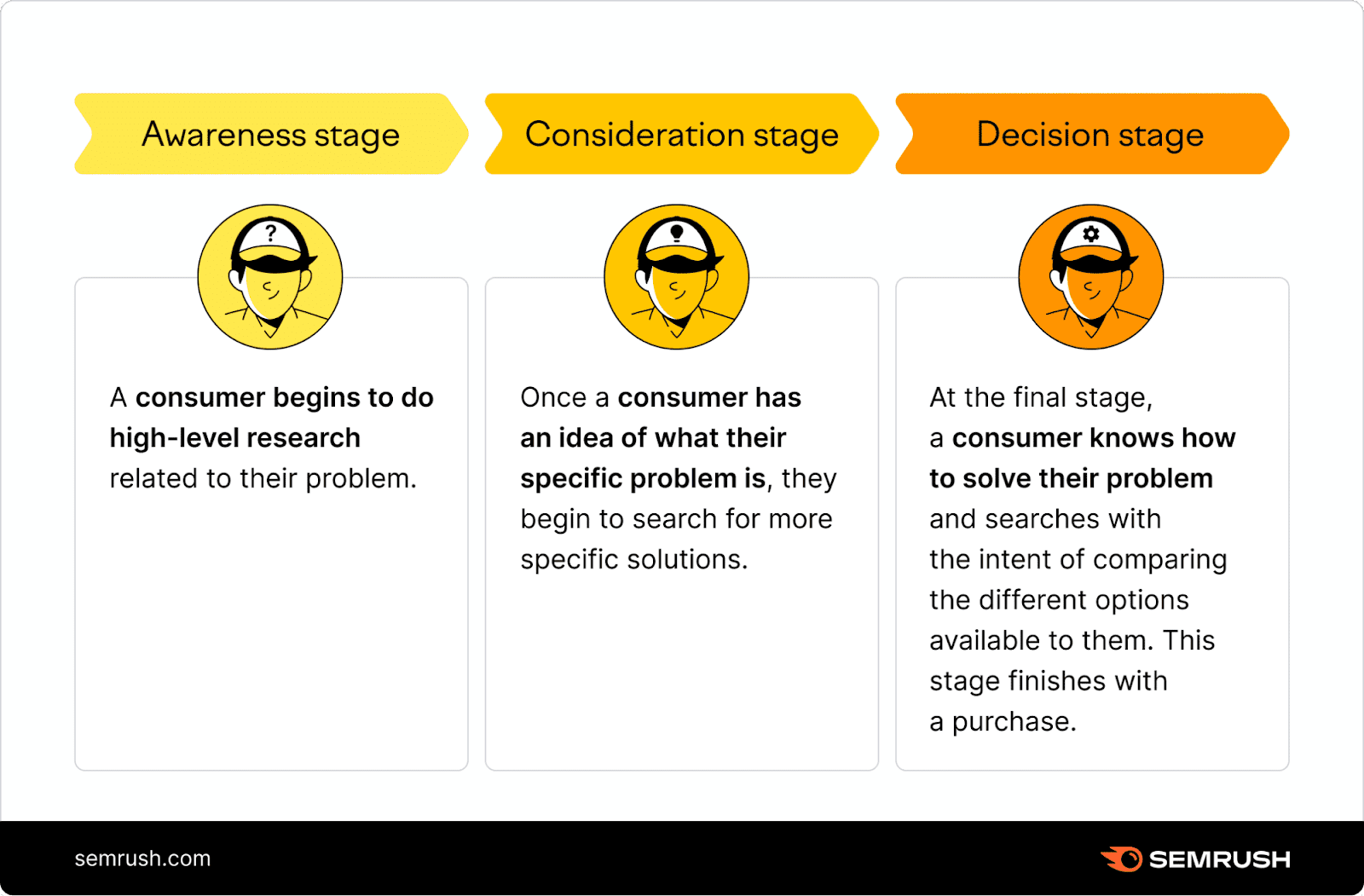
Awareness
Content marketing at this stage is intended to create awareness for your brand, products, or services.
This is where you attract your potential customers’ attention. And make them aware of their problems and your solutions.
You need to create content that provides high-level education and has broad appeal to capture the attention of as many relevant people as possible.
And you also likely need to optimize your content for SEO and social media platforms. So you can rank higher and get more shares and clicks.
Some of the best types of content for this step are blog posts, infographics, videos, podcasts, ebooks, and webinars.
Consideration
The second stage is where you nurture leads, provide information, and persuade them to consider your offer as the best option for their needs and wants.
At this stage, your best bet is to create content that’s persuasive and explains what makes you stand out.
You should segment your audience based on their interests, needs, and goals. And provide them with personalized content that matches their stage in the buyer’s journey.
Some examples of content types that work well for this stage are white papers, reports, and success stories.
Decision
The third and final stage is to convert leads into customers with content that drives them to take action.
You want to create content that instills a sense of urgency, addresses any last-minute objections, and makes it easy to take the next step.
Some of the best types of content for this stage are landing pages, customer reviews, pricing pages, and product pages.
Types of Content to Use in Content Marketing
To really understand what content marketing is, you need to know there are many different types of content.
And each type has its own advantages, disadvantages, and best practices.
Let’s explore some of the options.
Blog Posts
Blog posts are among the most popular and effective ways content marketers reach target audiences.
Why?
Because they allow you to share your knowledge and insights with your readers.
But more importantly, they can help you get to the top of Google’s results, drive organic traffic to your website, and build authority in your niche.
For example, we use our blog to create high-quality, in-depth, and actionable content on topics like SEO, social media, content marketing, and more.
And our blog gets over 1.5 million visitors per month worldwide:

That’s the power of blogging.
Social Media Posts
Social media is another popular (and powerful) type of content marketing.
It allows you to create and share content on platforms where your target audience is already active and engaged.
Which means it’s a great way to connect with your audience, increase brand awareness, and boost engagement.
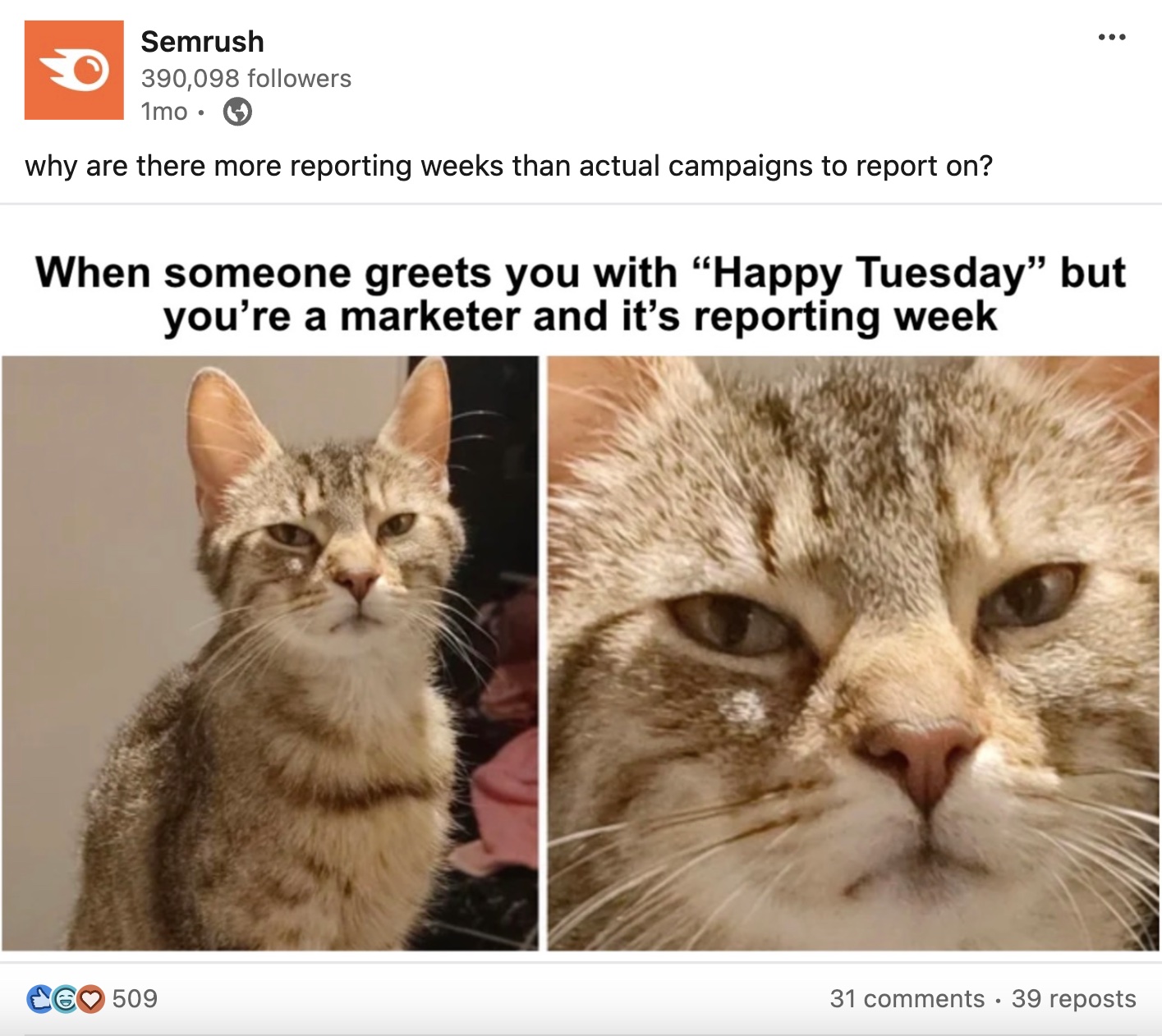
You can use social media to:
- Showcase your brand personality, voice, and values
- Provide value and entertainment to your audience and spark their interest
- Create shareable content that can reach more people and drive traffic to your site
- Engage with your audience and encourage them to comment, like, and follow your brand
- Build trust and loyalty with your customers and create a community of fans and advocates
Ebooks
Ebooks are digital publications businesses often use as a tool to engage their target audience, generate leads, and establish authority.
They’re typically more comprehensive than blog posts. And focus on a specific topic that showcases the business’s expertise.
Like this:
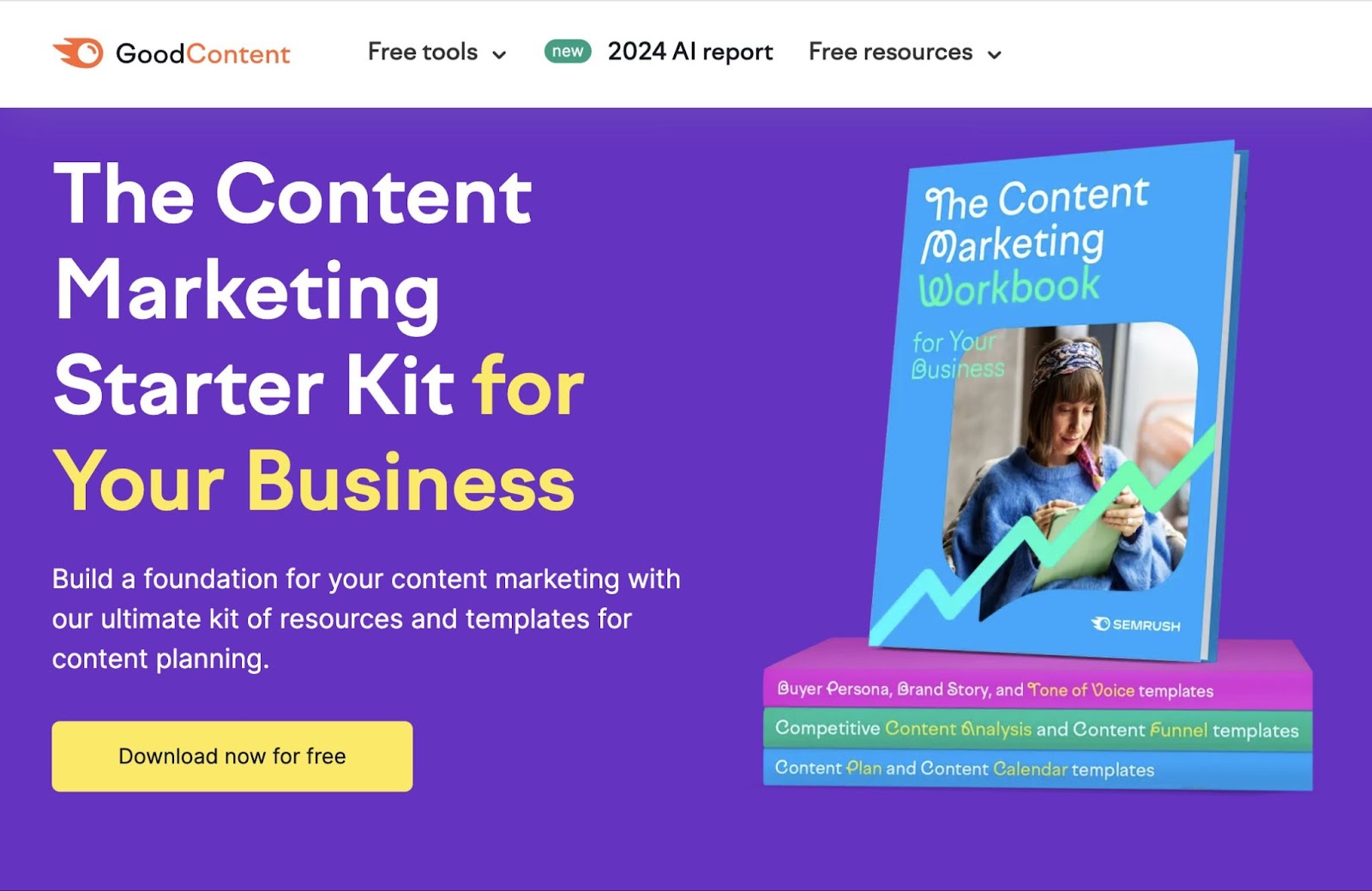
Ebooks are typically presented in a format that’s easy to download and read on different devices and screen sizes.
You can use ebooks to:
- Provide comprehensive information and solve specific problems
- Generate more leads and grow your email list by offering them as lead magnets
- Establish your expertise to build trust and credibility
- Drive more traffic to your site by promoting them on your blog, social media channels, and newsletter
- Repurpose existing content from blog posts, webinars, podcast episodes, and more
Email Marketing
Email marketing is one of the most direct and personal forms of content marketing. And it’s really effective.
It allows you to create and send content directly to your audience’s inbox. Where you have their full attention.
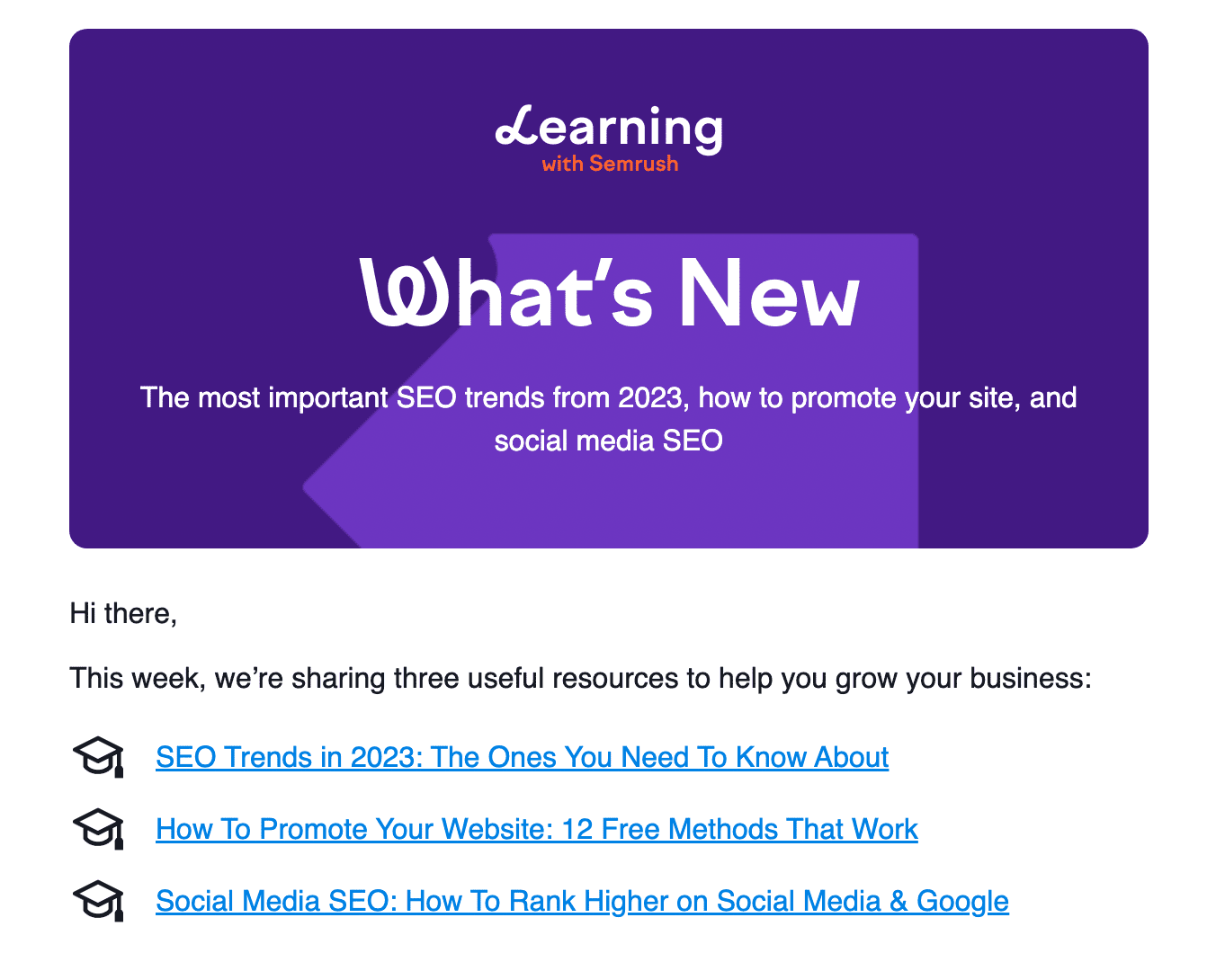
You can use email marketing to:
- Welcome new subscribers and introduce your brand
- Nurture leads and move them along the funnel
- Promote content, products, services, or offers
- Build relationships, trust, and loyalty
- Segment your audience and personalize your messages
Videos
Videos are an engaging and versatile type of content marketing.
How so?
They allow you to create and share content that’s visual, dynamic, and engaging for your audience. Helping you capture their attention, convey your message, and evoke emotions.
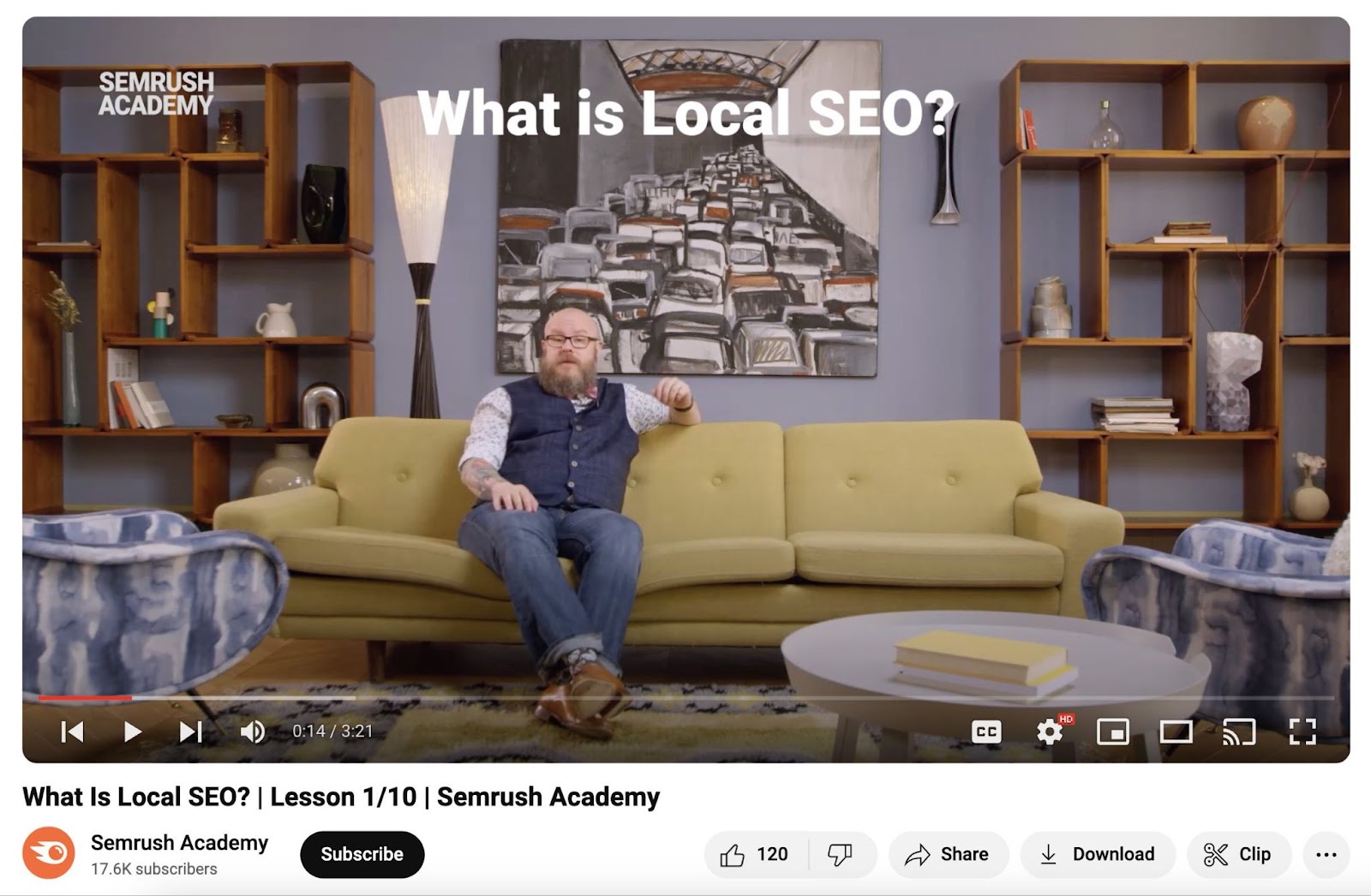
You can use videos to:
- Show how your products or services work—and how users can benefit from them
- Provide education and solve problems
- Create emotional and memorable content that can inspire and motivate
- Increase your visibility on platforms like YouTube, Facebook, and Instagram
- Boost conversions and sales by adding them to landing pages, sales pages, and emails
Podcast Episodes
Podcasts are digital audio programs available online for downloading or streaming.
They usually have a series of episodes that focus on a specific topic or theme, such as news, comedy, marketing, sports, or education.
And they can be listened to on devices like computers, tablets, or smartphones.
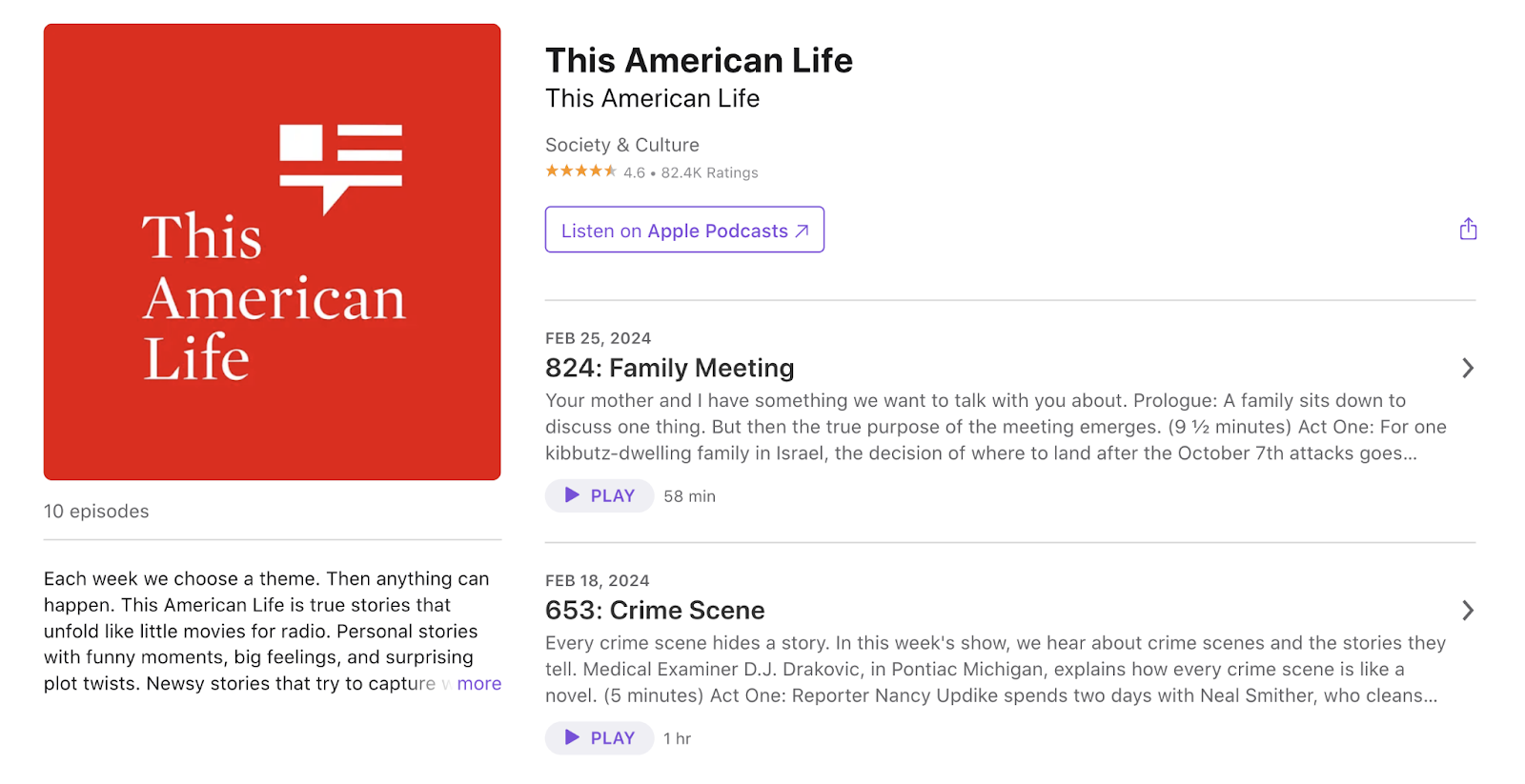
Podcasts can help you reach a wider and more engaged audience. Especially those who prefer listening over reading.
You can use podcasts to:
- Interview guests, experts, or influencers
- Discuss trends, news, or controversial subjects
- Increase your visibility and reach on platforms like Spotify, Apple Podcasts, and Google Podcasts
- Build a loyal and active community around your brand
Memes
Memes are a form of cultural expression that spread through imitation and variation.
They can be images, videos, texts, or other types of media that are humorous, informative, or provocative.
And they’re often shared online. Especially on social media—where they can reach a large audience.

You can use memes to:
- Showcase your brand personality, humor, and voice
- Relate to your audience and their pain points
- Engage with your audience and encourage them to comment, like, and interact
- Leverage popular trends and events to create timely content
Case Studies
Case studies are real stories that showcase how your product or service has helped your customers achieve their goals.
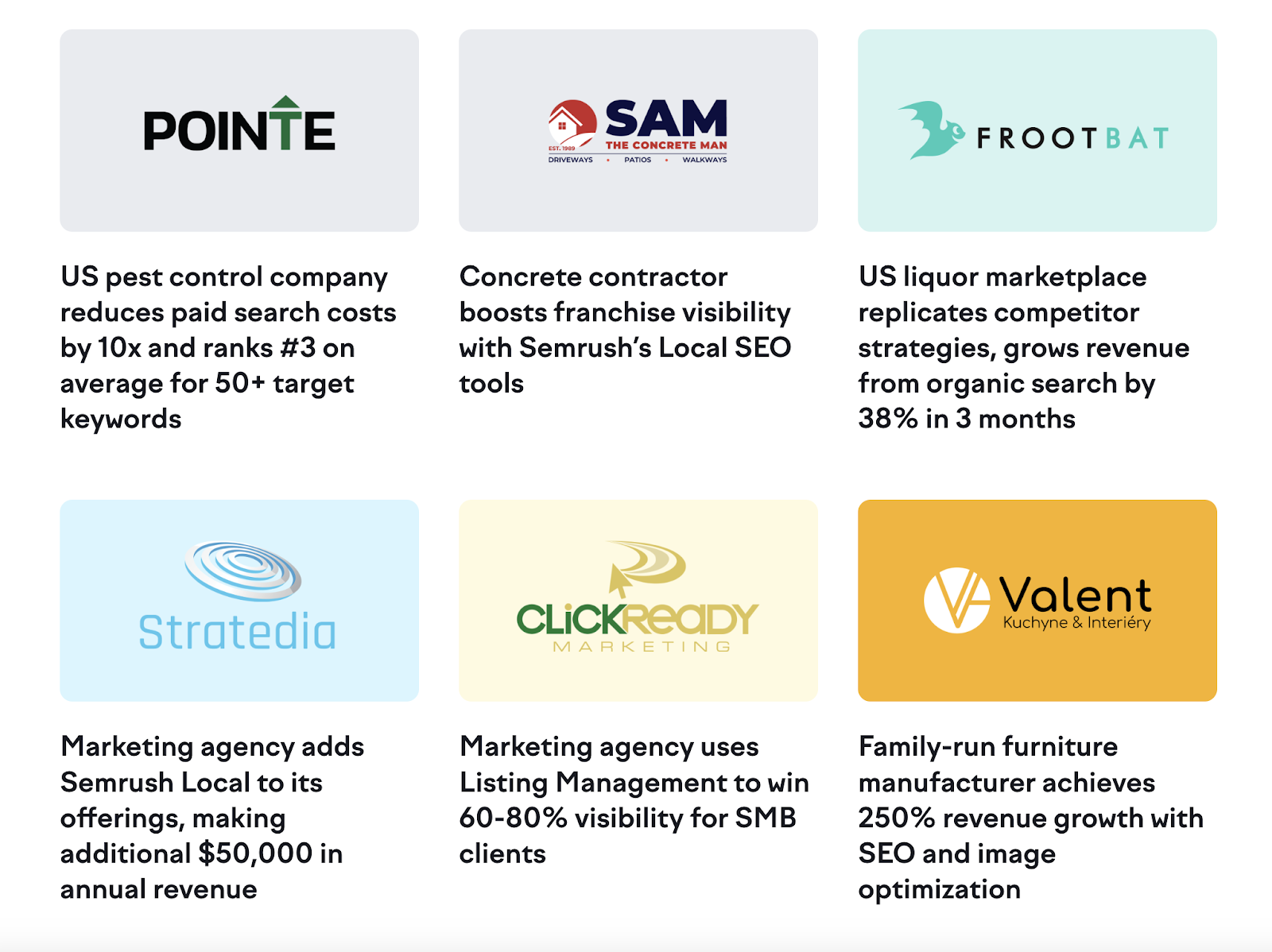
Case studies are great ways to share content that includes facts potential customers will be interested in, details about your product or service, and a persuasive narrative.
You can use them to:
- Provide social proof and credibility
- Highlight your value proposition
- Attract potential customers and help them move closer to making a purchase
- Repurpose existing content from articles, videos, or podcast episodes that have included details about and commentary from your customers
User-Generated Content
User-generated content (UGC) is any content (like images, videos, text, and audio) that’s created and shared by customers, fans, or followers online.
It’s totally different from traditional content because it’s created by amateurs rather than professionals. And is more interactive and participatory.

You can use UGC to:
- Leverage the power of word-of-mouth and peer recommendations
- Increase brand trust, loyalty, and advocacy
- Boost your social media presence and engagement
- Generate more content to reduce your workload
- Drive more traffic to your other content and boost conversions
How to Start Using Content Marketing
What is content marketing like in practice?
Let’s explore the main steps to take when building your content marketing strategy:
1. Define Your Goals & Audience
Before creating any content, you need to know two things: your goals and your audience.
Your goals are the specific outcomes you want to achieve with your content marketing.
For example, you might want to increase site traffic by a certain percentage or drive a specific number of leads.
Your audience is the group of people you want your content to reach.
For example, you might want to target small business owners, freelancers, bloggers, or students.
A quick way to find your target audience is to use a tool like One2Target.
Just enter up to five competitors’ domains and the tool will gather information about their audiences’ demographics, socioeconomics, and behavior.
Like this:
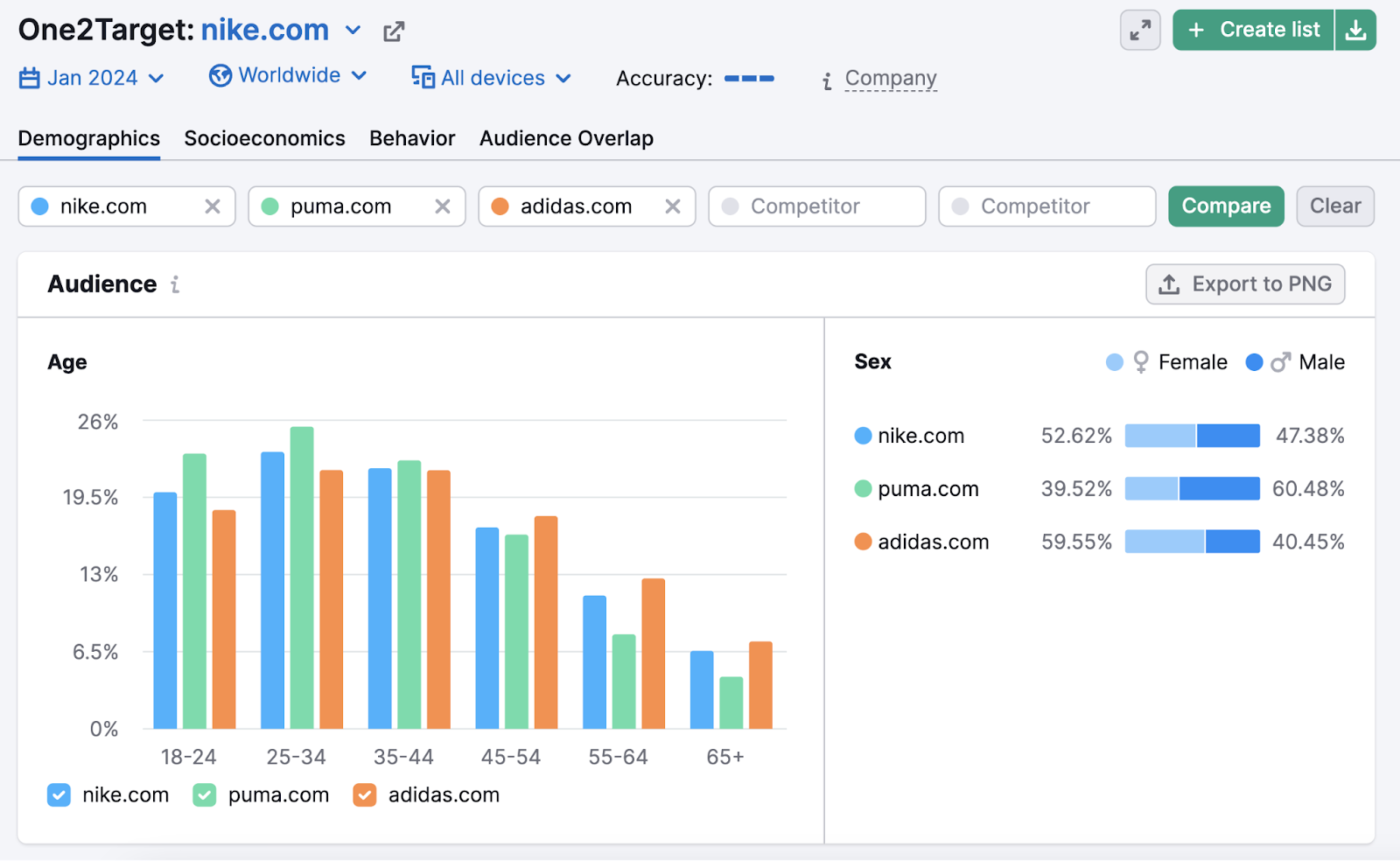
Here are some additional steps you can take to define your goals and audience:
- Review your current performance. What are your strengths and weaknesses? What are your opportunities and threats?
- Identify your ideal customer persona. Who are they? What are their pain points, needs, and desires? How can you help them?
- Conduct a competitor analysis. Who are your main competitors? What are they doing well and poorly? How can you differentiate yourself from them?
- Set the right types of goals. Specific, measurable, achievable, relevant, and time-bound (SMART) goals make it easy to see whether you’re on track. For example, a SMART goal could be: “Increase organic traffic by 50% in the next six months.”
- Choose key performance indicators (KPIs) that measure progress. For example, some common KPIs for content marketing are views, bounce rate, average engagement time, social shares, comments, email subscribers, etc.
By defining your goals and audience, you’ll have a clear direction and focus for your content marketing.
You’ll also be able to create content that resonates with your target audience and helps you achieve your desired results.
Further reading:
2. Determine Appropriate Content Types
You’ve defined your goals and audience. Now, you need to choose the best content types for your content marketing efforts.
Content types are the formats and styles of your content.
We discussed some of these earlier, including:
- Blog posts
- Ebooks
- Videos
- Podcast episodes
- Webinars
- Case studies
Don’t know where to start?
A great way is to reverse-engineer your competitors’ content strategies. See what’s working for them and replicate it in a better way.
Open Organic Research, enter any competitor’s domain, and head to the “Pages” tab.
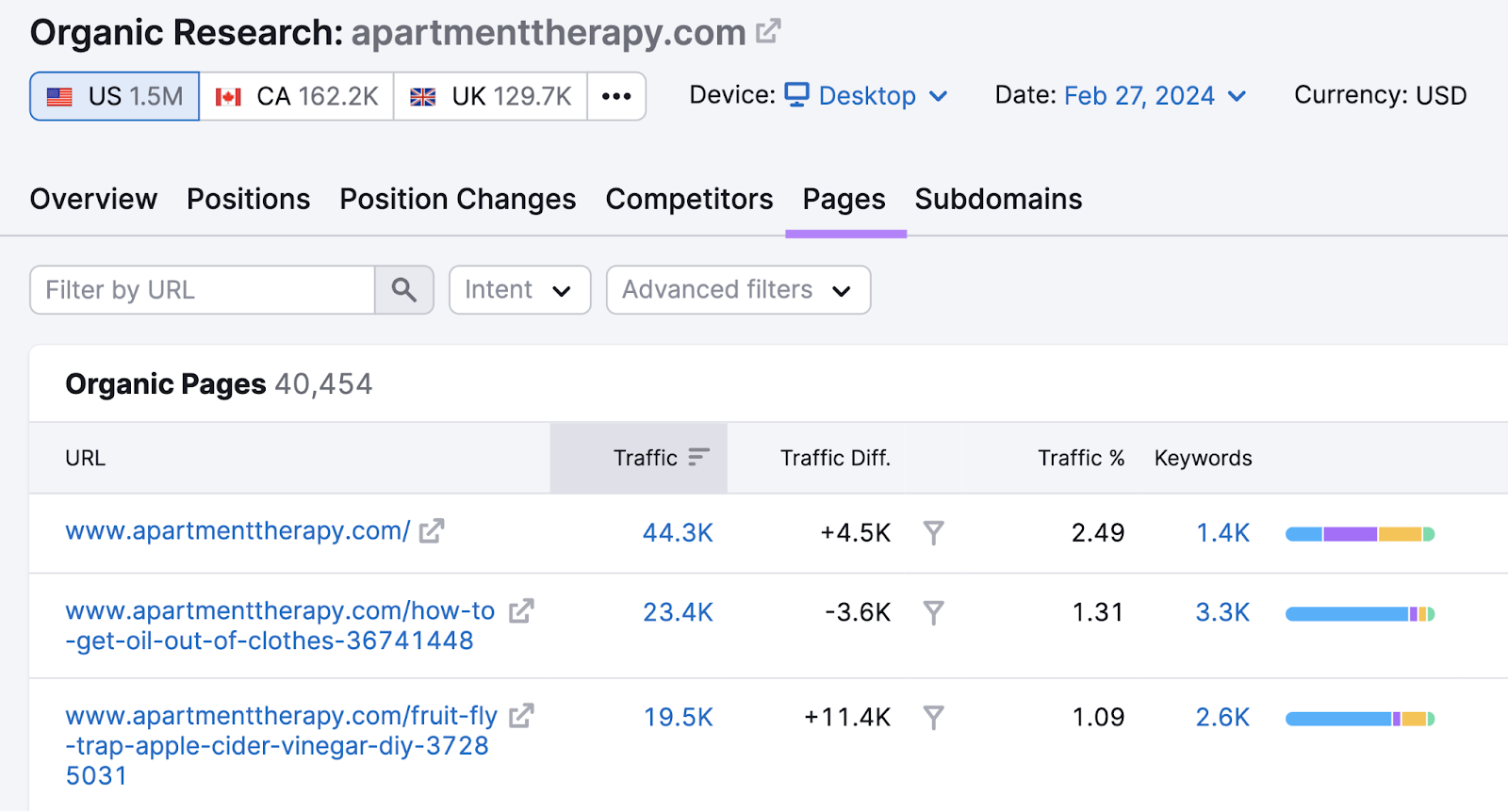
This is a list of that competitor’s pages, conveniently sorted by the estimated organic traffic they each bring in.
Click the icon next to the URL to see the actual page.

Browse through a few of the top pages. Repeat this process for your main competitors. And look for patterns.
For example:
- Do they use lots of visual assets?
- Is the content mostly long-form or short-form?
- Are the URLs mostly landing pages, ebooks, case studies, or something different?
Use the answers to these questions to guide your choice of content type.
You can also review your competitors’ social media accounts in a similar way.
Here are some additional tips for deciding which content types to use:
- Align content types with your goals. Different content types have different purposes and benefits. For example, blog posts are great for driving traffic, ebooks are great for generating leads, videos are great for increasing engagement, etc.
- Align content types with your audience. Some content types appeal to different audiences. For example, some audiences prefer visual content, some prefer audio content, some prefer interactive content, etc.
- Experiment and optimize. You don’t need to stick to one content type. Mix and match to see what works best. Track KPIs and adjust accordingly.
3. Set a Content Budget
Next, you need to set a content budget.
Your content budget is the amount of money you’re able to spend on your content marketing as a whole. It includes the costs of creating, distributing, and promoting your content.
But how do you set a content budget that works for your business?
Start here:
- Estimate content costs. Do some research to see roughly how much it would cost to produce content—think hiring writers, designers, editors, etc.
- Estimate distribution costs. These are the costs of getting your content in front of your audience, such as paying for ads, creating sponsored posts, leveraging influencer marketing, etc.
- Calculate your predicted return on investment (ROI): The ROI of your digital content marketing is a metric that shows your content revenue relative to your content costs
- Adjust your content budget accordingly. Based on your estimated costs and ROI, decide how much you can allocate to different content types and channels
By setting a content budget, you’ll be able to plan and manage your content marketing more efficiently and effectively.
4. Decide on Distribution Channels
Now you need to decide which places to distribute content to. Places where your audience hangs out and consumes content.
How?
There’s no one-size-fits-all answer. It depends on your niche, audience, goals, and resources.
But here are some general tips you can follow:
- Start with your own channels. These are channels you control like your website, blog, email list, social media profiles, etc. They’re the easiest and most cost-effective ways to distribute your content and build an audience.
- Expand to earned and paid channels. These are the channels you don’t own but can leverage. Like guest posting, podcasting, influencer marketing, media outreach, etc. They can help you reach new audiences, generate backlinks (links from other sites that point to yours), and increase your authority and credibility.
- Test and optimize. You don’t need to be everywhere. You need to be where it matters. So, test different channels to see what works best for you. Measure your results and optimize your content and strategy accordingly.
Further reading: SEO and Content Marketing: How to Combine Them Effectively
5. Decide on Your Content Schedule
It’s time to decide on the frequency of your content creation and distribution efforts.
For example, you might want to publish a blog post every week, a podcast every month, and a webinar every quarter.
Then, you need to schedule those in a content calendar to see exactly what you’ll create and when you’ll create it.
Like this example from our content calendar template:

To start, follow these tips:
- Assess your resources and capacity. What does your content budget look like? How many people are involved in your content team? What are their roles and responsibilities?
- Balance quality and quantity. You don’t necessarily need to create and distribute content every day. You need to create and distribute content that’s valuable, relevant, and engaging for your audience. Quality beats quantity every time.
- Experiment and optimize. You don’t have to stick to one content publishing cadence. Test different frequencies and publication times to see what works best for you. Track your KPIs and optimize accordingly.
Further reading: 4 Content Calendar Examples to Inspire Marketing Teams
6. Create High-Quality Content
You’ve done the hard work involved in planning.
What now?
It’s time to create some high-quality content.
High-quality content is content that’s:
- Valuable to your audience
- Original and unique
- Well-researched and accurate
- Well-written and easy to read
- Well-designed and visually appealing
- Optimized for SEO and conversions
Not sure where to start?
One of the easiest (and most effective) ways is to use our Content Marketing Platform.
It can help you find popular content ideas, headlines, and questions trending in your industry.
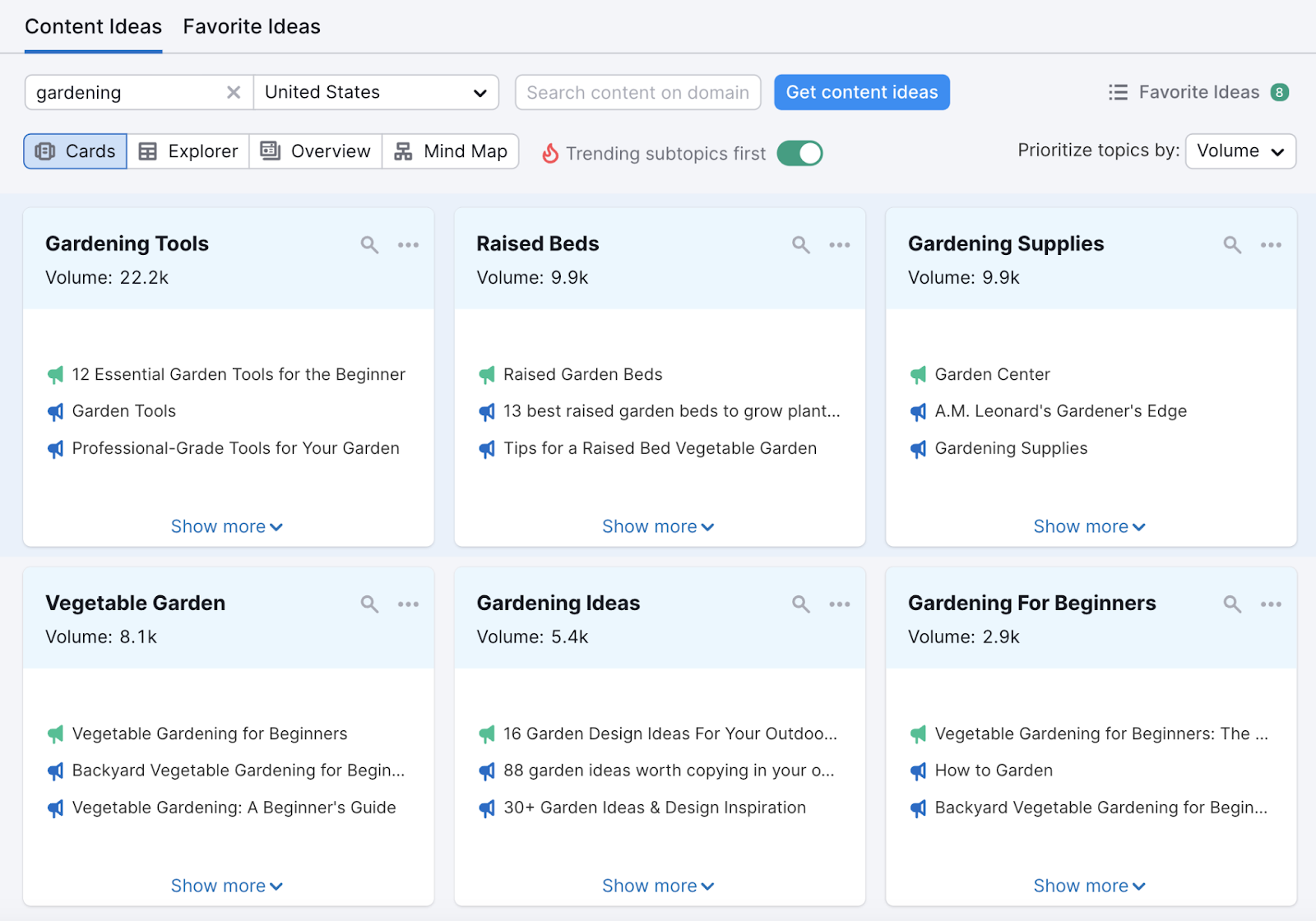
And it can help you write quality content that’s SEO-friendly, easy to read, original, and in the appropriate tone of voice.
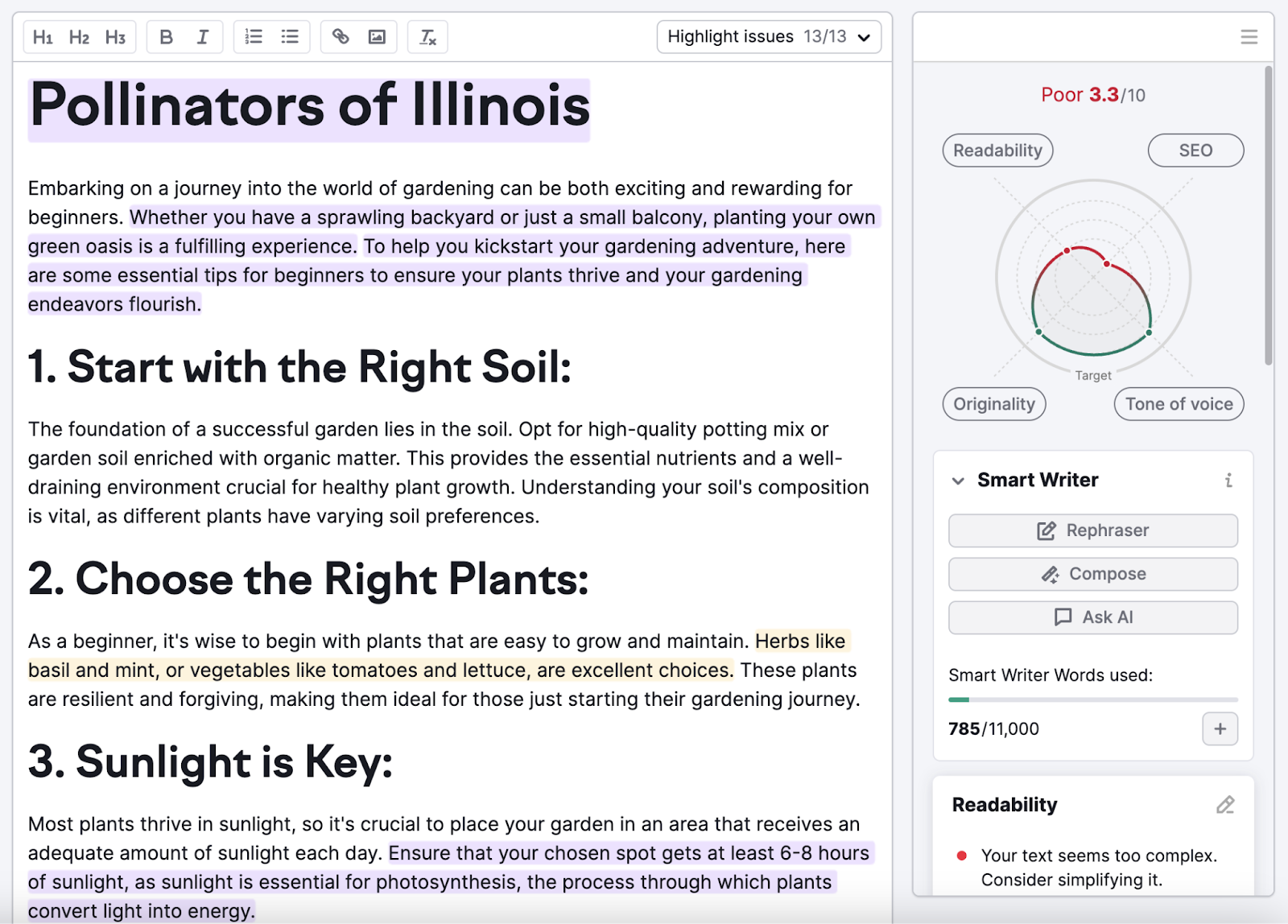
Here are some bonus tips:
- Follow a content creation process. This is a systematic and repeatable way of creating content, such as brainstorming, outlining, drafting, editing, proofreading, formatting, etc.
- Use content creation tools. These are tools that can help you create better content, such as Grammarly, Hemingway, and the SEO Writing Assistant
- Follow SEO writing best practices. These are tips that can help you create more effective content, such as using subheadings, bullet points, images, videos, calls to action, etc.
- Experiment and optimize. You don’t need to create perfect content. You need to create content that helps you reach your goals. So, test different content ideas and formats to see what resonates.
7. Monitor and Analyze Results
Your final step is to monitor and analyze your results.
You need to see how your content is performing and whether it’s helping you achieve your goals.
How?
Try following these steps:
- Use analytics tools. These are tools that can help you measure and track your content performance, such as Google Analytics, Google Search Console, and Semrush
- Use feedback tools. These are tools that can help you collect and analyze feedback from your audience, such as SurveyMonkey, Hotjar, and UserTesting
- Use reporting tools. These are tools that can help you create and share reports on your content results, such as Google Data Studio, Tableau, or Power BI
- Compare results with your goals. See how your content is performing against your SMART goals. Identify what’s working and what’s not.
- Make data-driven decisions. Based on your results and analysis, decide what actions you need to take to improve your marketing content. For example, you might want to create more or less content, change your content types or channels, or optimize your content for SEO or conversions.
Invest in Your Future with Content Marketing
Content marketing isn’t only about driving immediate results. It’s also an investment in your business’s future.
By creating high-quality, relevant, and valuable content, you can attract and retain customers for years to come.
And the best part about content marketing is you don’t need a huge budget or a large team to get started.
You just need clear goals, a solid plan, and a willingness to learn and improve.
Start your content marketing journey today and reap the benefits tomorrow.
Source link : Semrush.com
